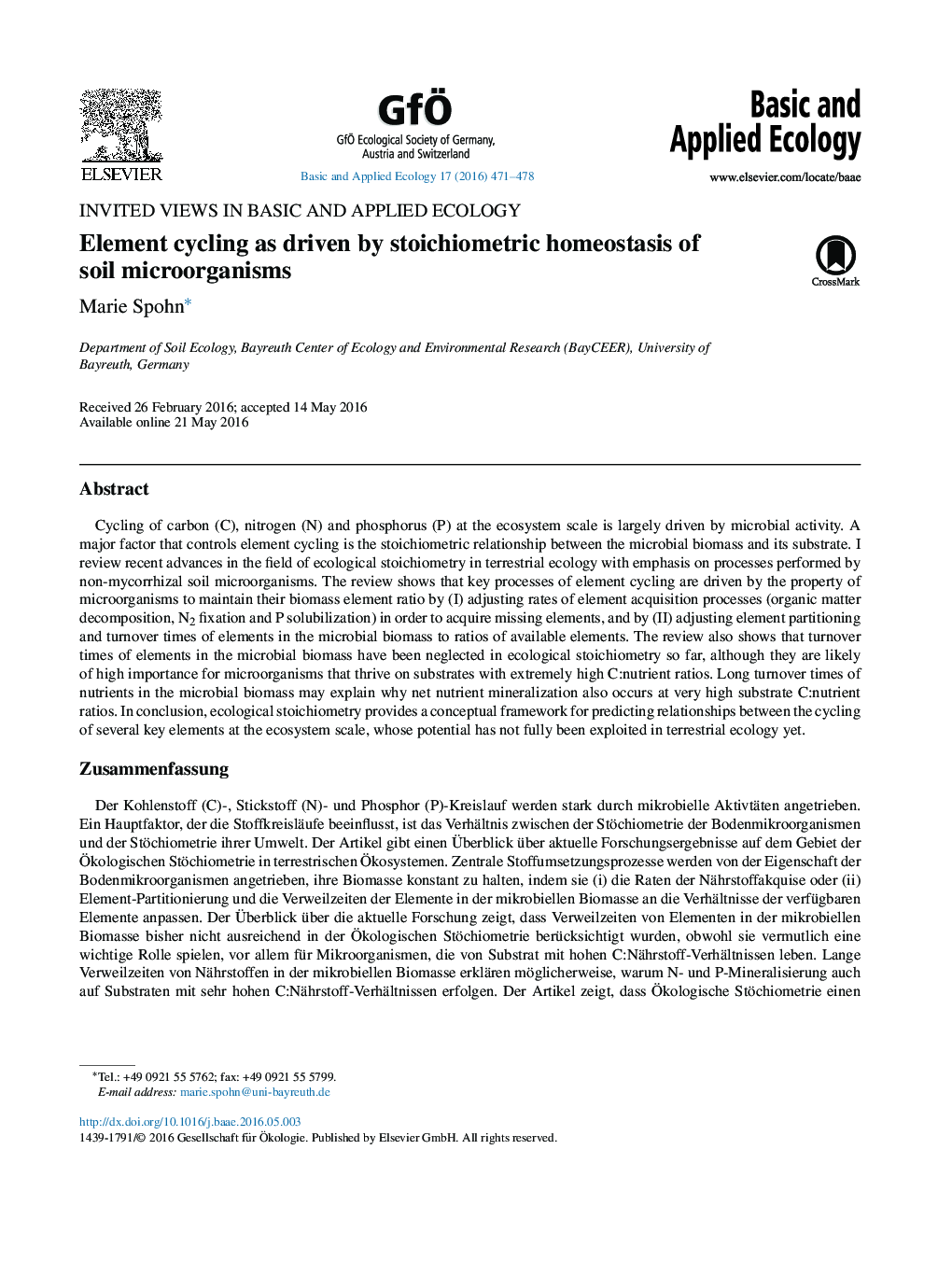| Article ID | Journal | Published Year | Pages | File Type |
|---|---|---|---|---|
| 4383849 | Basic and Applied Ecology | 2016 | 8 Pages |
•Ecological stoichiometry (ES) enables to predict the cycling of several key elements.•Element cycling is driven by soil microorganisms that maintain their biomass element ratio.•Microorganisms adjust the rates of processes of element acquisition.•Microorganisms adjust element partitioning and element turnover times in their biomass.•Turnover times of elements in the microbial biomass have been neglected in ES so far.
Cycling of carbon (C), nitrogen (N) and phosphorus (P) at the ecosystem scale is largely driven by microbial activity. A major factor that controls element cycling is the stoichiometric relationship between the microbial biomass and its substrate. I review recent advances in the field of ecological stoichiometry in terrestrial ecology with emphasis on processes performed by non-mycorrhizal soil microorganisms. The review shows that key processes of element cycling are driven by the property of microorganisms to maintain their biomass element ratio by (I) adjusting rates of element acquisition processes (organic matter decomposition, N2 fixation and P solubilization) in order to acquire missing elements, and by (II) adjusting element partitioning and turnover times of elements in the microbial biomass to ratios of available elements. The review also shows that turnover times of elements in the microbial biomass have been neglected in ecological stoichiometry so far, although they are likely of high importance for microorganisms that thrive on substrates with extremely high C:nutrient ratios. Long turnover times of nutrients in the microbial biomass may explain why net nutrient mineralization also occurs at very high substrate C:nutrient ratios. In conclusion, ecological stoichiometry provides a conceptual framework for predicting relationships between the cycling of several key elements at the ecosystem scale, whose potential has not fully been exploited in terrestrial ecology yet.
ZusammenfassungDer Kohlenstoff (C)-, Stickstoff (N)- und Phosphor (P)-Kreislauf werden stark durch mikrobielle Aktivtäten angetrieben. Ein Hauptfaktor, der die Stoffkreisläufe beeinflusst, ist das Verhältnis zwischen der Stöchiometrie der Bodenmikroorganismen und der Stöchiometrie ihrer Umwelt. Der Artikel gibt einen Überblick über aktuelle Forschungsergebnisse auf dem Gebiet der Ökologischen Stöchiometrie in terrestrischen Ökosystemen. Zentrale Stoffumsetzungsprozesse werden von der Eigenschaft der Bodenmikroorganismen angetrieben, ihre Biomasse konstant zu halten, indem sie (i) die Raten der Nährstoffakquise oder (ii) Element-Partitionierung und die Verweilzeiten der Elemente in der mikrobiellen Biomasse an die Verhältnisse der verfügbaren Elemente anpassen. Der Überblick über die aktuelle Forschung zeigt, dass Verweilzeiten von Elementen in der mikrobiellen Biomasse bisher nicht ausreichend in der Ökologischen Stöchiometrie berücksichtigt wurden, obwohl sie vermutlich eine wichtige Rolle spielen, vor allem für Mikroorganismen, die von Substrat mit hohen C:Nährstoff-Verhältnissen leben. Lange Verweilzeiten von Nährstoffen in der mikrobiellen Biomasse erklären möglicherweise, warum N- und P-Mineralisierung auch auf Substraten mit sehr hohen C:Nährstoff-Verhältnissen erfolgen. Der Artikel zeigt, dass Ökologische Stöchiometrie einen konzeptionellen Ansatz bietet, der erlaubt, das Verhältnis von Umsatzprozessen verschiedener Elemente vorauszusagen, und dessen Potential in der terrestrischen Ökologie noch nicht vollständig ausgeschöpft ist.
